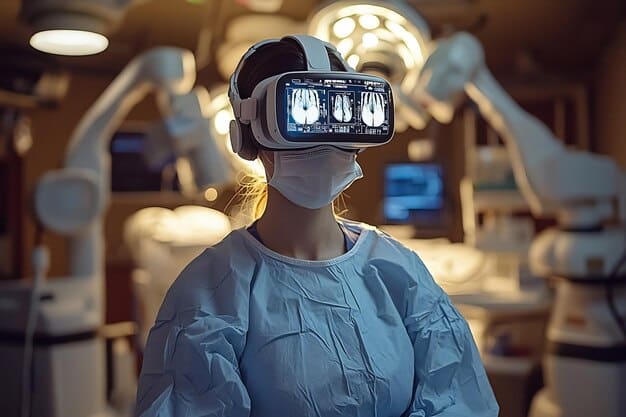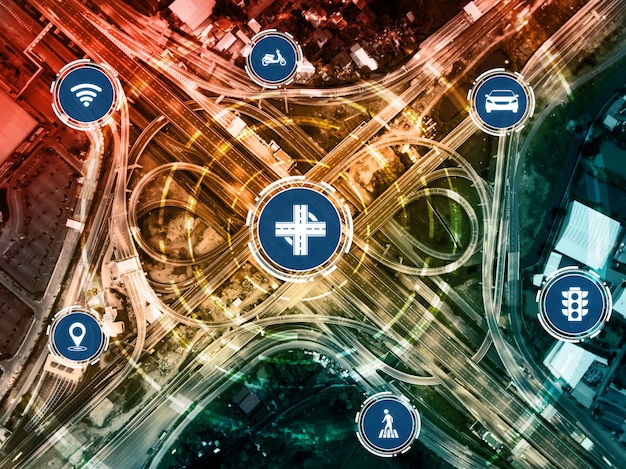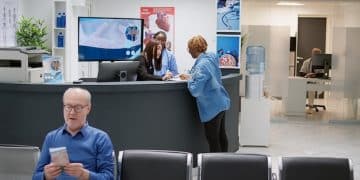5G’s impact on remote surgery & emergency in rural US

The advent of 5G technology fundamentally transforms healthcare delivery, particularly in remote surgery and emergency response, by enabling high-speed, low-latency connectivity crucial for real-time data transmission and robotic control in underserved rural US communities, bridging geographical divides and enhancing patient outcomes.
The convergence of advanced telecommunications and medical science heralds a new era for healthcare, especially in addressing the critical disparities faced by rural populations. Specifically, the impact of 5G on remote surgery and emergency response in rural US communities stands out as a transformative force, promising to redefine access, efficiency, and quality of care.
The Digital Divide in Rural Healthcare
Rural communities across the US have long struggled with limited access to specialized medical care, a challenge often exacerbated by geographical isolation and a scarcity of healthcare professionals. This ‘digital divide’ translates into delayed diagnoses, reduced treatment options, and poorer health outcomes compared to urban areas. Traditional telemedicine, while helpful, has been hampered by insufficient bandwidth and high latency, making advanced procedures like remote surgery largely unfeasible. Bridging this gap requires not just technology, but a robust, reliable, and high-speed network infrastructure capable of supporting the most demanding medical applications.
The current state of healthcare in rural America reveals significant disparities. Many rural hospitals operate on thin margins, often facing closure, which further limits local access to care. Specialist physicians are scarce, forcing patients to travel long distances for critical appointments. Emergency response times can be significantly longer due to vast distances and limited resources. These challenges highlight an urgent need for innovative solutions that can transcend physical barriers and bring advanced medical capabilities directly to those in need, without requiring long commutes or extensive infrastructure overhaul in every small town.
Access to Specialists and Telemedicine
The shortage of specialized medical personnel in rural areas is a pervasive issue, often leading to referrals to distant urban centers. Telemedicine has served as a partial remedy, allowing virtual consultations, but its capabilities have been inherently limited by the underlying internet infrastructure. For complex cases requiring detailed imagery or real-time interaction, standard broadband often falls short. This is where 5G’s superior capabilities become a game-changer, facilitating interactions that mirror in-person consultations.
- Enhanced Virtual Consultations: 5G allows for high-definition video streams, enabling clearer visual assessment.
- Real-Time Data Sharing: Large medical images (MRIs, CT scans) can be transmitted instantly.
- Specialist Collaboration: Facilitates multiple specialists remote viewing and discussing patient data seamlessly.
- Reduced Travel Burden: Decreases the need for patients to travel long distances for specialist opinions.
In essence, the digital divide is not merely about internet access, but about access to high-quality, specialized internet access that meets the stringent demands of modern healthcare, particularly in scenarios where lives are at stake. Overcoming this requires not just deployment of 5G, but strategic planning to ensure coverage extends to the most isolated pockets, and that healthcare providers are equipped to harness its full potential for patient benefit.
5G’s Technical Leaps: Speed, Latency, and Capacity
At its core, 5G represents a monumental leap in wireless technology, far surpassing its predecessors. Its three foundational pillars—eMBB (enhanced Mobile Broadband), URLLC (Ultra-Reliable Low-Latency Communications), and mMTC (massive Machine Type Communications)—are precisely what the healthcare sector needs to revolutionize remote operations. These technical advancements are not incremental; they are paradigm-shifting, enabling applications that were once confined to science fiction.
The speed of 5G, with theoretical peak speeds of up to 10 gigabits per second, dwarfs 4G’s capabilities. This immense bandwidth is crucial for transmitting large medical files, high-definition video feeds, and complex data streams necessary for sophisticated medical procedures. More critically, it allows for near-instantaneous communication, essential for applications where even milliseconds of delay can have dire consequences, such as remote surgical control or real-time diagnostic imaging. The ability to move vast quantities of data quickly and efficiently underpins all advanced healthcare applications.
Ultra-Reliable Low-Latency Communications (URLLC)
URLLC is perhaps the most revolutionary aspect of 5G for healthcare. Latency, the delay between sending and receiving data, is reduced to potentially as low as 1 millisecond. This near-real-time communication capability is critical. In remote surgery, for example, a surgeon controlling a robotic arm needs to see and react as if they were physically present, without any perceptible lag. URLLC ensures that commands are executed immediately, and sensory feedback is received without delay, maintaining precision and safety.
The reliability component of URLLC is equally vital. In medical procedures, dropped connections or intermittent service are simply unacceptable. 5G networks are designed to offer extremely high levels of reliability, ensuring that critical data pathways remain open and stable, even in congested environments. This robust connection guarantees that life-saving procedures are not jeopardized by network instability, providing a level of confidence not previously possible with wireless technologies. This unwavering reliability fosters trust in remote medical interventions.
Combined, these features make 5G an enabler for truly transformative medical applications, moving beyond simple video calls to complex, interactive, and highly responsive systems. The implications for critical care, especially in remote or underserved areas, are profound, opening doors to highly specialized interventions that were previously geographically restricted. The potential to save lives and improve outcomes by democratizing access to expert medical care, irrespective of location, is immense.
Remote Surgery: Bridging Gaps with Robotic Precision
Remote surgery, or telesurgery, is no longer a futuristic concept but a rapidly advancing reality, significantly propelled by 5G technology. Traditionally, the primary barriers to widespread adoption have been latency and bandwidth limitations. Even a slight delay in signal transmission can compromise precision, rendering complex procedures impossible or unsafe. 5G’s URLLC capabilities directly address these limitations, making telesurgery a viable and safe option for patients in rural areas who might otherwise lack access to specialized surgical expertise. Robotic surgical systems, already common in urban hospitals, can now extend their reach.
The concept involves a surgeon controlling robotic instruments from a distant location, guided by high-definition video feeds and tactile feedback. This requires an almost instantaneous connection to ensure the surgeon’s movements are precisely replicated by the robot without any discernible lag. 5G networks provide the necessary low latency and high bandwidth to facilitate this intricate dance between human skill and machine precision. This means that a highly specialized surgeon, perhaps based in a major medical center, can perform complex operations on a patient located hundreds of miles away in a rural hospital, effectively taking their expertise directly to the patient.

Advantages for Rural Communities
For rural communities, the benefits of remote surgery are manifold. It eliminates the need for patients to travel long distances for specialized surgical care, reducing financial burdens, logistical challenges, and patient discomfort. It also means that critical, time-sensitive procedures can be performed more quickly, improving prognosis and reducing complications. Beyond individual patient benefits, it enhances the capabilities of rural hospitals, allowing them to offer a broader range of services and potentially attract more patients, bolstering their financial stability.
- Enhanced Access: Rural patients gain access to expert surgeons regardless of geography.
- Reduced Patient Burden: Eliminates the need for costly and stressful patient travel.
- Timely Interventions: Enables quicker access to critical, time-sensitive surgeries.
- Resource Optimization: Maximize the utilization of highly skilled surgeons who can serve multiple locations.
The integration of haptic feedback systems with 5G further enhances the surgeon’s experience, providing tactile sensations that mimic the resistance and texture of tissues, allowing for a more intuitive and precise operation. This level of sensory information is vital for delicate surgical procedures and was previously impossible over conventional wireless networks. Remote surgery enabled by 5G is not just about extending reach; it’s about replicating the in-person surgical experience as closely as possible, ensuring safety and efficacy for the patient.
Transforming Emergency Response in Isolated Areas
In emergency situations, every second counts. For rural communities, prolonged emergency response times due to vast distances, limited ambulance availability, and poor communication infrastructure can mean the difference between life and death. 5G technology promises to dramatically improve emergency medical services (EMS) by enabling faster, more efficient, and more informed responses, even in the most isolated areas. This isn’t merely about getting an ambulance to the scene faster; it’s about empowering first responders with real-time data and remote guidance, transforming the very nature of pre-hospital care.
With 5G, ambulances can become mobile diagnostic and treatment units. Paramedics can transmit real-time, high-definition video of the patient’s condition to emergency room physicians, allowing for immediate remote diagnosis and guidance. This includes live streaming vital signs, medical imaging (e.g., ultrasound scans performed on-site), and even detailed wound assessments. This constant flow of critical information allows hospital staff to prepare for the patient’s arrival, anticipate needs, and even begin treatment protocols while the patient is still en route, drastically cutting down on precious minutes and improving chances of survival and recovery.
Real-Time Data Transmission and Remote Diagnostics
The ability to transmit large volumes of high-quality data in real-time is revolutionary for emergency response. Paramedics can use handheld devices connected via 5G to perform basic diagnostics, such as remote ultrasound or ECGs, and receive immediate feedback from specialists at a distant hospital. This means a diagnosis can be made and treatment initiated much sooner, potentially averting critical deterioration before the patient even reaches definitive care. Think of stroke victims where every minute saved in diagnosis and treatment significantly impacts long-term outcomes.
Furthermore, 5G can facilitate the use of augmented reality (AR) tools for paramedics. An AR overlay could guide them through complex procedures, displaying anatomical information or step-by-step instructions for emergency interventions. This empowers frontline responders with extended capabilities, reducing reliance on direct physical presence of a specialist, and enhancing their skill set in the field. Such advancements can lead to more effective triage and more appropriate initial care, especially when critical medical expertise isn’t immediately available on the ground.
- Live Patient Monitoring: Share vital signs and video feeds with hospital teams in real-time.
- Remote Expert Consultation: Paramedics can receive immediate guidance from specialists.
- Faster Triage: Enables more accurate assessment and preparation before hospital arrival.
- Enhanced Field Diagnostics: Support for remote imaging and diagnostic tools on the scene.
The integration of 5G in emergency services also extends to improved communication between dispatch centers, ambulances, and hospitals. Smart routing based on real-time traffic and urgent care needs, facilitated by 5G connectivity, can optimize deployment and response. Ultimately, this technology acts as a force multiplier for a strained EMS system in rural areas, ensuring that geographical distance no longer dictates the quality or timeliness of life-saving interventions.
Challenges and Implementation Hurdles
While the promise of 5G in revolutionizing rural healthcare is immense, the path to widespread implementation is fraught with significant challenges. Overcoming these hurdles requires a concerted effort from government, industry, and healthcare providers. The deployment of 5G infrastructure in vast, sparsely populated rural areas is inherently more complex and costly than in dense urban environments. This economic reality is perhaps the most significant initial barrier, requiring substantial investment.
The ‘last mile’ problem—connecting individual homes and facilities in remote areas—remains a persistent issue. Even with 5G towers, ensuring consistent, high-quality connectivity within every clinic, home, or moving ambulance requires meticulous planning and resource allocation. Regulatory frameworks also need to evolve to support and standardize the use of 5G in sensitive medical contexts, addressing concerns like data privacy, cybersecurity, and liability in remote procedures. Establishing clear guidelines and robust security protocols is paramount to fostering trust and ensuring patient safety.
Infrastructure Development and Funding
Building out 5G networks across rural America is a colossal undertaking. Unlike urban deployments where existing infrastructure can often be upgraded, rural areas frequently lack even basic fiber optic backbones necessary to support 5G towers. This means entirely new infrastructure, including new towers and fiber lines, must be constructed, which is capital-intensive and time-consuming. Private telecommunications companies may be hesitant to invest heavily in areas with low population density, as the return on investment can be less attractive.
- High Capital Costs: Significant investment needed for new towers and fiber.
- Low Population Density: Less attractive ROI for private sector compared to urban areas.
- “Last Mile” Connectivity: Challenges in extending coverage to truly remote locations.
- Regulatory Streamlining: Need for efficient permitting and land access processes.
Government subsidies, public-private partnerships, and innovative funding models will be crucial to bridge this investment gap. Initiatives like the FCC’s Universal Service Fund and specific rural broadband programs play a vital role, but their scope often needs to expand to meet the specific demands of 5G for healthcare applications. Moreover, incentivizing telecommunications companies through tax breaks or grants could accelerate deployment in these underserved regions, transforming a market disadvantage into a strategic investment for public health.
Spectrum Availability and Cybersecurity
Another major challenge lies in spectrum availability and management. 5G operates across various spectrum bands, each with different propagation characteristics. Deploying the optimal blend of low, mid, and high-band spectrum to ensure both wide coverage and high capacity in rural settings is technically complex. Additionally, the increasing reliance on wireless networks for critical medical data raises significant cybersecurity concerns. Protecting patient information and ensuring the integrity of healthcare systems against cyber threats is paramount and requires continuous vigilance and investment in advanced security measures.

The complexity of securing 5G medical networks is intensified by the high stakes involved. A breach could compromise sensitive patient data, or worse, disrupt life-saving operations. Robust encryption, multi-factor authentication, and constant threat monitoring will be standard requirements. Furthermore, training healthcare professionals and IT staff in rural areas on cybersecurity best practices will be essential to create a resilient ecosystem. Overcoming these implementation hurdles requires not just technological prowess but also strategic foresight and collaborative governance, ensuring that the promise of 5G in healthcare is realized safely and equitably.
The Future Outlook: Integrated and Intelligent Healthcare Systems
The integration of 5G into healthcare is not a static endpoint but a dynamic progression towards a more integrated, intelligent, and responsive medical ecosystem. Beyond remote surgery and emergency response, 5G will act as the foundational layer for an array of advanced healthcare applications, leading to a paradigm shift in how medical services are conceived and delivered. The proliferation of connected medical devices, the rise of artificial intelligence (AI) in diagnostics, and the advent of personalized medicine all hinge significantly on the capabilities that 5G provides.
Imagine ubiquitous patient monitoring through wearables, transmitting continuous health data to AI-powered platforms that can detect anomalies and predict health deteriorations before symptoms even manifest. Such systems would allow for proactive interventions, reducing hospitalizations and improving chronic disease management, particularly beneficial for elderly or isolated rural residents. The sheer volume of data generated by these connected devices would be unmanageable without 5G’s capacity and speed, allowing for real-time analysis and actionable insights.
IoT and AI in Healthcare
The Internet of Medical Things (IoMT) is set to explode with 5G, connecting everything from smart beds and surgical instruments to wearable sensors and drug delivery systems. This interconnectedness generates massive datasets, which, when analyzed by AI, can lead to groundbreaking insights. AI algorithms can assist in early disease detection by processing complex medical images or physiological data with unprecedented speed and accuracy. For rural healthcare providers, this means having access to analytical tools and diagnostic support that previously required highly specialized human expertise, effectively augmenting their capabilities.
AI’s role extends to predictive analytics, where patterns in health data can predict disease outbreaks or individual patient risks, enabling preventative care strategies. In a remote setting, AI-driven diagnostics can reduce the need for physical tests or consultations, streamlining processes and making care more accessible. Furthermore, AI can optimize resource allocation within rural healthcare systems, from scheduling appointments to managing supplies, improving operational efficiency and reducing costs. This fusion of 5G and AI heralds a future where healthcare is not just reactive but profoundly proactive and personalized.
Ethical Considerations and Long-Term Impact
As 5G reshapes healthcare, it also brings significant ethical considerations to the forefront. Issues of data privacy, algorithmic bias in AI, and equitable access to these advanced technologies must be meticulously addressed. Ensuring that rural communities, which stand to benefit most from 5G-enabled healthcare, are not left behind due to infrastructure disparities or socio-economic factors, is paramount. Policymakers and industry leaders must collaborate to create frameworks that prioritize ethical deployment and widespread accessibility.
The long-term impact of 5G on rural US healthcare will likely extend beyond direct medical interventions. By improving health outcomes and attracting investment in technology, it can spur economic development in these areas, making them more attractive places to live and work. A healthier population is a more productive population, and enhanced healthcare infrastructure can serve as a catalyst for broader rural revitalization. The synergistic effect of technology, medicine, and community development holds the promise of a more robust and resilient future for America’s rural heartland.
| Key Area | 5G’s Impact |
|---|---|
| 🚀 Remote Surgery | Enables highly precise robotic operations from afar with ultra-low latency. |
| 🚑 Emergency Response | Provides real-time patient data and remote expert guidance for paramedics. |
| 🌐 Rural Access | Bridges geographical disparities in healthcare access for underserved communities. |
| 🧠 Future Healthcare | Powers IoMT, AI diagnostics, and proactive health monitoring. |
Frequently Asked Questions About 5G in Rural Healthcare
▼
5G’s ultra-reliable low-latency communications (URLLC), with delays potentially as low as 1 millisecond, are crucial for remote surgery. This ensures that a surgeon’s commands to a robotic arm are executed instantaneously, and vital haptic feedback is received without perceptible lag, allowing for precise and safe operations.
▼
Key challenges include the high cost of building new infrastructure in sparsely populated areas, the “last mile” problem of connecting isolated facilities, and ensuring robust cybersecurity for sensitive medical data. Overcoming these requires significant investment and strategic partnerships.
▼
Yes, significantly. 5G allows paramedics to transmit real-time, high-definition video and patient vital signs to emergency room physicians while en route. This enables remote diagnosis, immediate guidance for on-site treatment, and allows hospitals to prepare better for patient arrival, potentially saving critical minutes.
▼
5G will power the Internet of Medical Things (IoMT), enabling widespread use of connected wearables for continuous patient monitoring. It will also facilitate AI-powered diagnostics and predictive analytics, allowing for proactive, personalized care and optimizing resource allocation within rural healthcare systems.
▼
While the core 5G technology is ready, widespread adoption in rural settings faces significant infrastructure and funding hurdles. Technical readiness for advanced applications is high, but equitable deployment requires substantial investment and collaborative efforts to bridge the digital divide.
Conclusion
The transformative potential of 5G in revolutionizing healthcare for rural US communities is undeniable, particularly in the realms of remote surgery and emergency response. By offering unparalleled speed, ultra-low latency, and enhanced reliability, 5G can effectively dismantle geographical barriers, extending specialized medical care to underserved populations. While significant challenges remain in terms of infrastructure development, funding, and cybersecurity, the long-term benefits—ranging from improved health outcomes and reduced patient burdens to the fostering of integrated, intelligent healthcare systems—underscore the critical importance of a concerted effort to realize this vision. As 5G networks continue to expand, they promise to build a more equitable, efficient, and resilient healthcare landscape for all Americans, especially those in the nation’s heartland.





